Best Monsoon Treks in Nepal
By embracing the unique beauty and challenges of trekking in Nepal during the monsoon season and following the essential safety guidelines, you can enjoy a memorable and life-changing experience in the majestic Himalayas.
By embracing the unique beauty and challenges of trekking in Nepal during the monsoon season and following the essential safety guidelines, you can enjoy a memorable and life-changing experience in the majestic Himalayas.
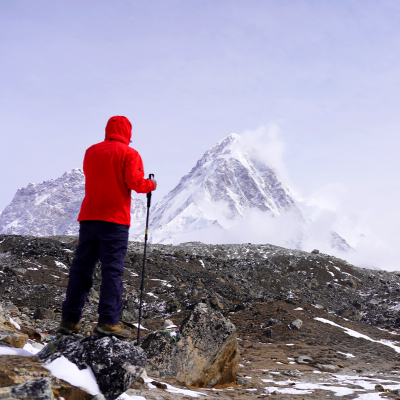
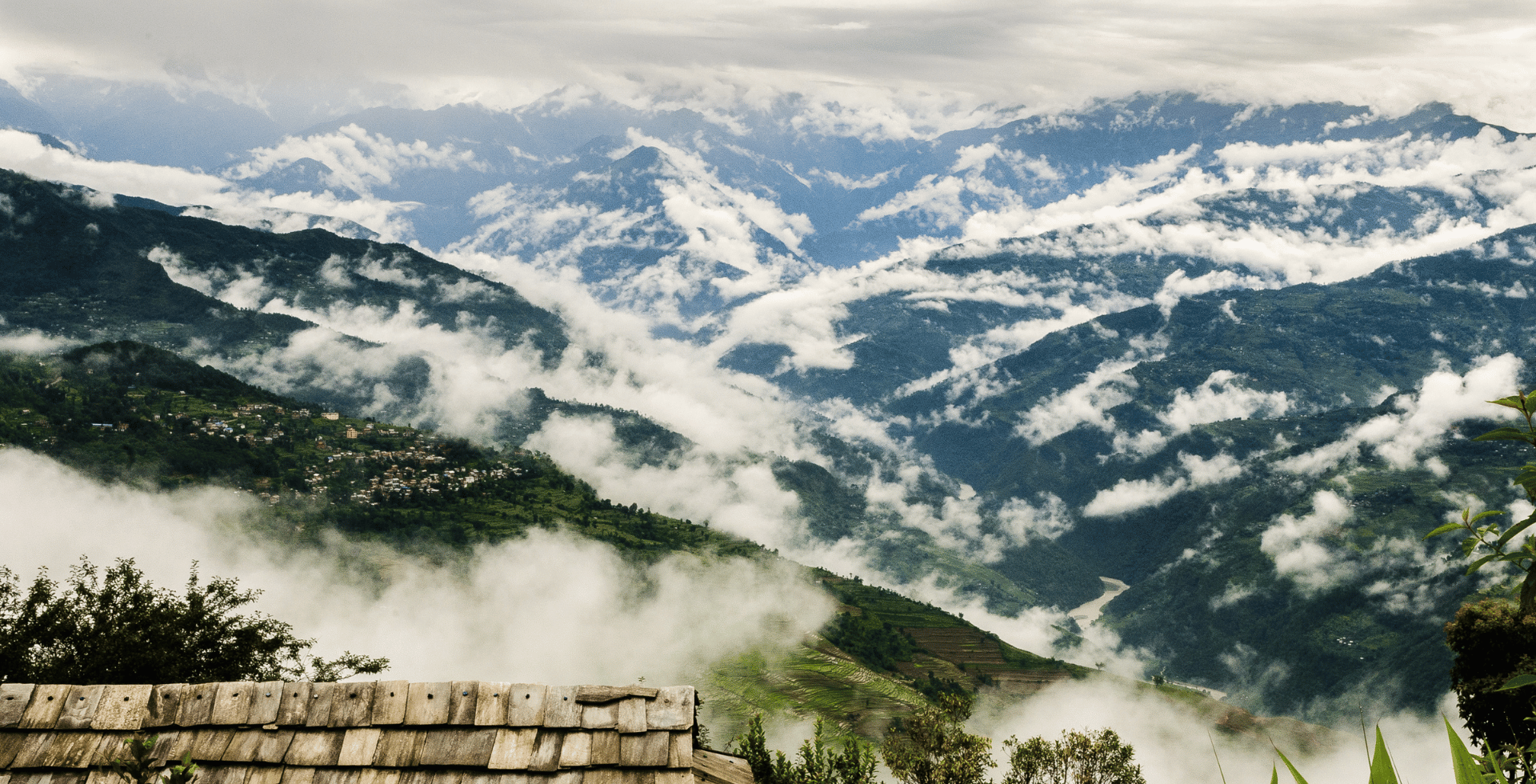
Nestled between the towering peaks of the Himalayas, Nepal is a paradise for adventure seekers and nature enthusiasts alike. With its rich cultural heritage, diverse landscapes, and some of the highest peaks in the world, including the iconic Mount Everest, Nepal has become a popular trekking destination for travelers across the globe. The country offers a wide array of trekking routes, catering to all levels of experience and fitness, making it an ideal destination for a life-changing adventure.
The monsoon season in Nepal typically spans from June to September, bringing heavy rainfall, increased humidity, and frequent cloud cover to the region. While this season is often seen as less desirable for trekking due to the challenging weather conditions, there are still a few trails that remain accessible and rewarding during this time. In fact, the monsoon season offers its own unique charms, such as lush green landscapes, fewer crowds, and a more authentic glimpse into the daily lives of the local people.
The purpose of this article is to provide a detailed guide on the best monsoon treks in Nepal, highlighting the distinctive experiences they offer, as well as the necessary preparations and precautions to take for a safe and enjoyable trekking experience. By showcasing the beauty and adventure of these lesser-known trails, we aim to inspire travelers to embark on an unforgettable journey through Nepal's breathtaking landscapes during the monsoon season.
The monsoon season in Nepal is marked by a distinct set of characteristics that can impact the trekking experience. Understanding these features will help trekkers prepare for the unique challenges and opportunities presented during this time of year.
Typical Duration (June to September):
The monsoon season typically lasts from June to September, with the heaviest rainfall occurring in July and August. During these months, the country experiences a significant increase in precipitation, transforming the landscapes into lush, green vistas.
Heavy rainfall: As the monsoon sets in, Nepal experiences torrential downpours on a regular basis. The heavy rainfall can cause trails to become muddy and slippery, making it essential for trekkers to exercise caution and wear appropriate footwear.
Occasional landslides: The increased rainfall can also trigger landslides, particularly in the steep and unstable terrains. It is crucial to stay updated on local weather conditions and follow the advice of experienced guides to ensure safety.
Limited visibility: The monsoon clouds often cloak the high peaks, resulting in limited visibility. This can make it difficult to enjoy the stunning views typically associated with trekking in Nepal. However, on clear days, the monsoon can also bring crisp, clean air and dramatic, cloud-shrouded vistas.
Trekking during the monsoon season in Nepal may present challenges, but it also offers some unique advantages that can make the experience worthwhile and memorable. Some of the benefits of trekking during this time include:
Lush Landscapes:
The monsoon rains bring life to Nepal's flora and fauna, transforming the landscapes into verdant valleys, vibrant wildflowers, and thriving ecosystems. The lush greenery provides a breathtaking backdrop for trekkers, offering a different perspective compared to the drier months.
Fewer Crowds:
As many trekkers avoid the monsoon season, trails are often less crowded, allowing for a more peaceful and immersive experience. This also means that popular teahouses and lodges are less busy, providing a more intimate and relaxing atmosphere after a long day of trekking.
Authentic Cultural Encounters:
With fewer tourists around, the monsoon season offers a more authentic glimpse into the daily lives of the local people. This can lead to richer cultural exchanges and a deeper understanding of Nepal's diverse communities and traditions.
Lower Costs:
During the monsoon season, there may be lower prices for accommodations and other services due to decreased demand. This can make trekking more affordable and accessible for budget-conscious travelers.
Unique Wildlife Experiences:
The monsoon season is a time of rejuvenation for Nepal's wildlife. As the landscapes become more fertile, many species of animals become more active, providing unique opportunities for wildlife enthusiasts to witness a thriving ecosystem.
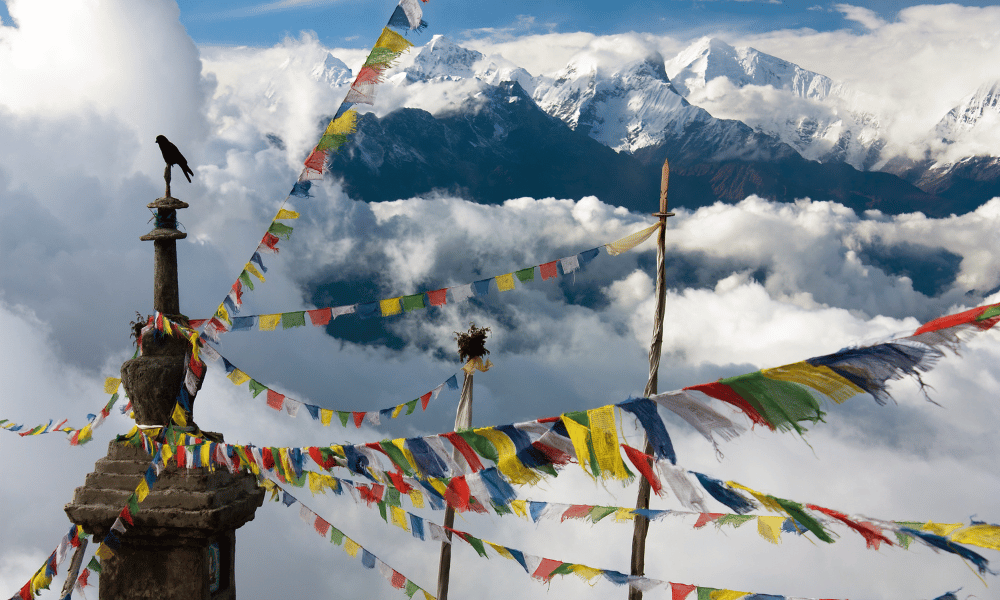
Dramatic Sceneries:
While the monsoon clouds can sometimes limit visibility, they also create dramatic and mesmerizing sceneries when the skies clear. The interplay between clouds, light, and mountains can result in unforgettable views that are distinctly different from those experienced in the dry season.
While trekking during the monsoon season requires careful planning and preparation, the unique advantages it offers can make it a truly rewarding experience for adventurous and flexible travelers.
Not all trekking routes are suitable for monsoon trekking, as some may be more prone to landslides or difficult to navigate in heavy rain. It's crucial to choose trails that are less affected by the monsoon, such as those in rain-shadow areas or lower altitude treks with more stable terrain. Researching and consulting with experienced guides or trekking agencies can help in identifying the best monsoon treks.
Preparing the right gear is essential for a safe and comfortable monsoon trek. Some necessary items include:
Waterproof clothing: A high-quality rain jacket and rain pants are crucial for staying dry during downpours.
Waterproof backpack cover: This helps protect your belongings from getting wet.
Sturdy trekking shoes: Waterproof and breathable trekking shoes with good grip are necessary for navigating muddy and slippery trails.
Quick-drying clothing: Lightweight, moisture-wicking clothes can help you stay comfortable and dry more quickly.
Trekking poles: These provide extra stability on slippery trails.
Warm layers: Temperatures may drop during evenings, so it's essential to have warm clothing for layering.
Insect repellent: The monsoon season can bring an increase in insects, making repellent a useful addition to your gear.
Following safety measures can help ensure a successful and enjoyable monsoon trek:
Hire a knowledgeable guide: A local guide can help you navigate the trails, provide updates on weather conditions, and ensure you stay safe during the trek.
Stay updated on weather forecasts: Regularly check weather updates and plan your trekking days accordingly.
Avoid river crossings during heavy rainfall: Rivers can rise rapidly during monsoon rains, making crossings dangerous. Wait for the water levels to recede before attempting to cross.
Be prepared for delays: Landslides or heavy rain may cause delays or changes in your itinerary. Maintain flexibility in your schedule to accommodate these unforeseen events.
Start your trek early in the day: Rainfall is usually heavier in the afternoon, so starting your trek early can help you avoid the heaviest downpours.
Stay hydrated and maintain proper nutrition: Even though the temperatures may be cooler, it's essential to drink plenty of water and maintain a balanced diet to keep your energy levels high.
By taking these precautions and considerations into account, you can maximize your chances of a safe and enjoyable monsoon trekking experience in Nepal.
|
|
|
|
|
|
|
|
|
|
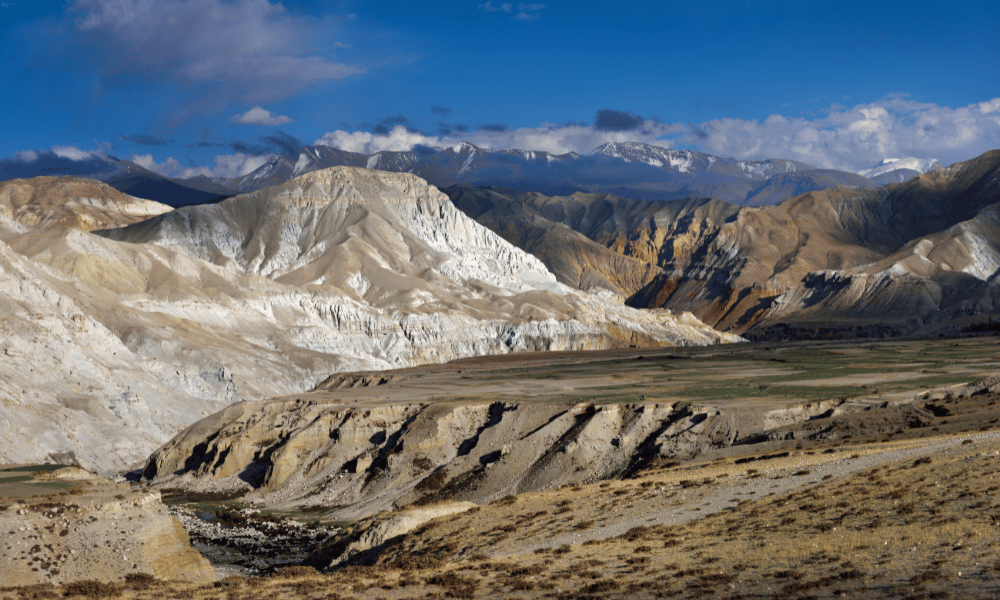
The Upper Mustang Trek takes you through the remote and arid region of Mustang in Nepal, which lies in the rain-shadow of the Annapurna and Dhaulagiri mountain ranges. This unique landscape remains relatively unaffected by the monsoon, making it an ideal trekking destination during this season. The trek offers an opportunity to explore the ancient Kingdom of Lo, characterized by its striking rock formations, centuries-old monasteries, and traditional Tibetan culture.
Lo Manthang: The walled city of Lo Manthang is the cultural and political center of the Upper Mustang, where you can witness the traditional lifestyle of the locals and explore ancient monasteries.
Unique landscape: The Upper Mustang features a distinct arid landscape with colorful rock formations, caves, and cliffs, contrasting the lush greenery of other regions in Nepal.
Ancient monasteries: Visit centuries-old monasteries, such as Thubchen Gompa and Choser Cave Monastery, which hold significant cultural and religious importance.
Traditional Tibetan culture: Experience the rich Tibetan culture and heritage that has been preserved in this remote region, largely untouched by modern influences.
Tiji Festival: If your trek coincides with the annual Tiji Festival, usually held in May, you can witness the vibrant and colorful celebration that takes place in Lo Manthang.
Trekking Duration and Difficulty Level:
The Upper Mustang Trek typically takes around 12-16 days to complete, depending on your pace and acclimatization. The trek is considered moderate in difficulty, with daily walking distances of 4-6 hours on average. The highest point of the trek is at an altitude of 3,810 meters (12,500 feet) in Lo Manthang.
Tips for Trekking During the Monsoon Season:
Acquire the necessary permits: Upper Mustang is a restricted area, and trekkers need to obtain a special permit along with the Annapurna Conservation Area Permit (ACAP) and the Trekkers' Information Management System (TIMS) card.
Hire a guide: A knowledgeable local guide can help ensure a safe and enjoyable trekking experience, as they are familiar with the trails and can provide valuable insights into the region's culture and history.
Prepare for variable weather: Despite being in the rain-shadow, the Upper Mustang can still experience occasional rain during the monsoon. Pack waterproof clothing and gear to stay dry and comfortable.
Be mindful of altitude: The trek involves gradual ascents to high altitudes. Take your time to acclimatize properly and be aware of the symptoms of altitude sickness.
Respect local customs and culture: Upper Mustang is culturally sensitive, and it's important to be respectful of local traditions and customs while interacting with the people and visiting religious sites.
By considering these tips and embracing the unique landscape and culture of the Upper Mustang, trekkers can enjoy a truly memorable experience during the monsoon season in Nepal.
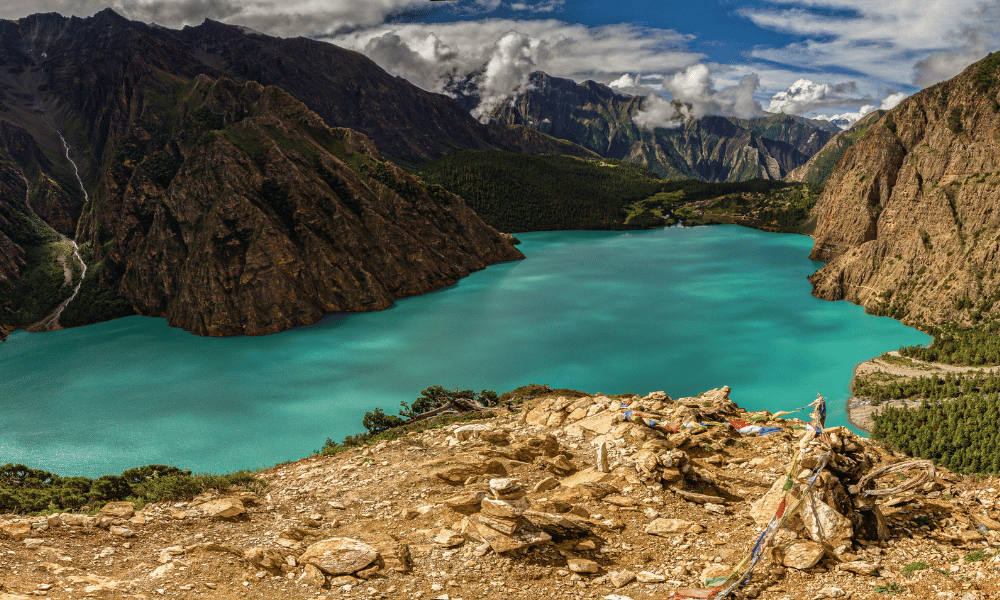
The Lower Dolpo Trek takes you through the remote and isolated region of Dolpo in western Nepal, which lies in the rain-shadow of the Dhaulagiri massif. This off-the-beaten-path trek offers a unique opportunity to experience the untouched natural beauty, diverse landscapes, and rich cultural heritage of this lesser-known region. The Lower Dolpo is a suitable trekking destination during the monsoon season due to its relatively drier conditions.
Phoksundo Lake: The pristine, turquoise Phoksundo Lake is a highlight of the trek, renowned for its stunning beauty and surrounding cliffs and forests.
Shey Gompa: Visit the ancient Shey Gompa, a significant monastery with historical and cultural importance, situated near the base of Crystal Mountain.
Diverse landscapes: The Lower Dolpo trek offers a range of landscapes, from lush forests and alpine meadows to arid cliffs and high mountain passes.
Traditional culture: Experience the unique and rich culture of the Dolpo people, who have maintained their traditional way of life in this remote region.
Wildlife: The region is home to diverse wildlife, including the elusive snow leopard, blue sheep, and Himalayan tahr.
Trekking Duration and Difficulty Level:
The Lower Dolpo Trek typically takes around 18-21 days to complete, depending on your pace and chosen route. The trek is considered moderate to challenging in difficulty, with daily walking distances of 5-7 hours on average. The highest point of the trek is the Numa La Pass at an altitude of 5,190 meters (17,028 feet).
Tips for Trekking During the Monsoon Season:
Obtain necessary permits: Trekkers are required to obtain a restricted area permit for Lower Dolpo, along with the Shey Phoksundo National Park entry permit.
Hire a guide and porter: A knowledgeable local guide can help ensure a safe and enjoyable trekking experience, while a porter can assist with carrying heavy gear and supplies.
Prepare for variable weather: Despite being in the rain-shadow, the Lower Dolpo can still experience occasional rain during the monsoon. Pack waterproof clothing and gear to stay dry and comfortable.
Acclimatize properly: The trek involves high-altitude passes and gradual ascents. Take your time to acclimatize properly and be aware of the symptoms of altitude sickness.
Respect local customs and culture: While interacting with the local people and visiting religious sites, it is essential to be respectful of their customs, traditions, and beliefs.
By considering these tips and embracing the natural beauty and unique culture of Lower Dolpo, trekkers can enjoy an unforgettable monsoon trekking experience in Nepal.
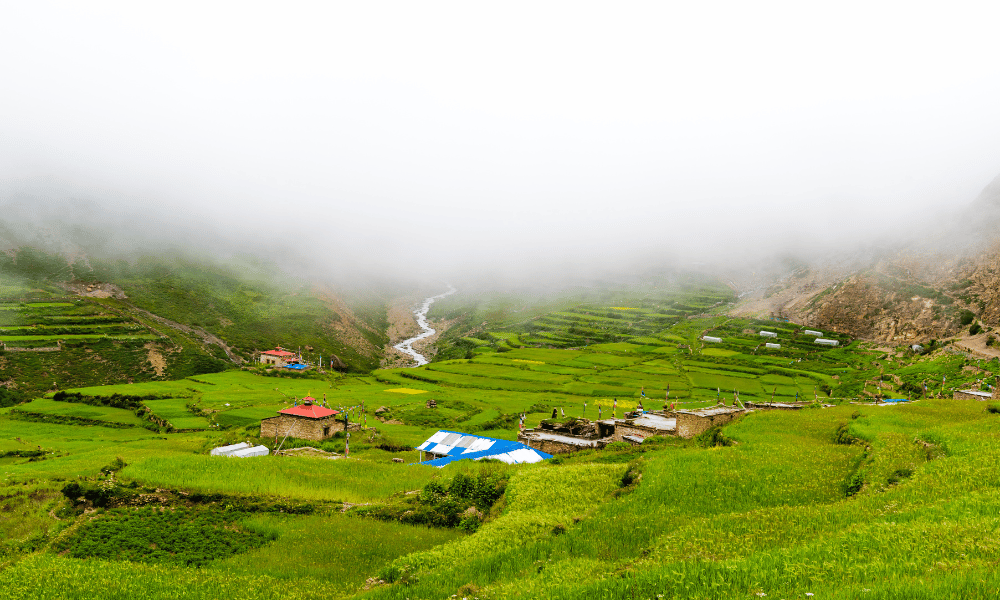
The Nar Phu Valley Trek takes you through the remote and hidden valleys of Nar and Phu in the Annapurna region of Nepal. This off-the-beaten-path trek offers a unique opportunity to explore the unspoiled landscapes, ancient villages, and the rich cultural heritage of the region. The Nar Phu Valley Trek is suitable for trekking during the monsoon season, as it lies in the rain-shadow of the Annapurna range.
Ancient villages: The trek takes you through the ancient and preserved villages of Nar and Phu, where you can witness traditional stone houses and the local way of life.
Unique landscape: The Nar Phu Valley features a range of landscapes, from lush forests and arid cliffs to high mountain passes and glacial valleys.
Tashi Lhakhang Gompa: Visit the historic Tashi Lhakhang Gompa, an important Buddhist monastery in the region.
Kang La Pass: Cross the challenging Kang La Pass at 5,320 meters (17,454 feet), which offers stunning panoramic views of the Annapurna massif and surrounding peaks.
Cultural experience: The region is home to the Tibetan-influenced Nar and Phu communities, allowing trekkers to immerse themselves in the unique culture and traditions.
Trekking Duration and Difficulty Level:
The Nar Phu Valley Trek typically takes around 12-15 days to complete, depending on your pace and chosen route. The trek is considered moderate to challenging in difficulty, with daily walking distances of 5-7 hours on average. The highest point of the trek is the Kang La Pass at an altitude of 5,320 meters (17,454 feet).
Tips for Trekking During the Monsoon Season:
Obtain necessary permits: Trekkers need to obtain a restricted area permit for the Nar Phu Valley, along with the Annapurna Conservation Area Permit (ACAP) and the Trekkers' Information Management System (TIMS) card.
Hire a guide and porter: A knowledgeable local guide can help ensure a safe and enjoyable trekking experience, while a porter can assist with carrying heavy gear and supplies.
Prepare for variable weather: Despite being in the rain-shadow, the Nar Phu Valley can still experience occasional rain during the monsoon. Pack waterproof clothing and gear to stay dry and comfortable.
Acclimatize properly: The trek involves high-altitude passes and gradual ascents. Take your time to acclimatize properly and be aware of the symptoms of altitude sickness.
Respect local customs and culture: While interacting with the local people and visiting religious sites, it is essential to be respectful of their customs, traditions, and beliefs.
By considering these tips and embracing the natural beauty and unique culture of the Nar Phu Valley, trekkers can enjoy a memorable monsoon trekking experience in Nepal.
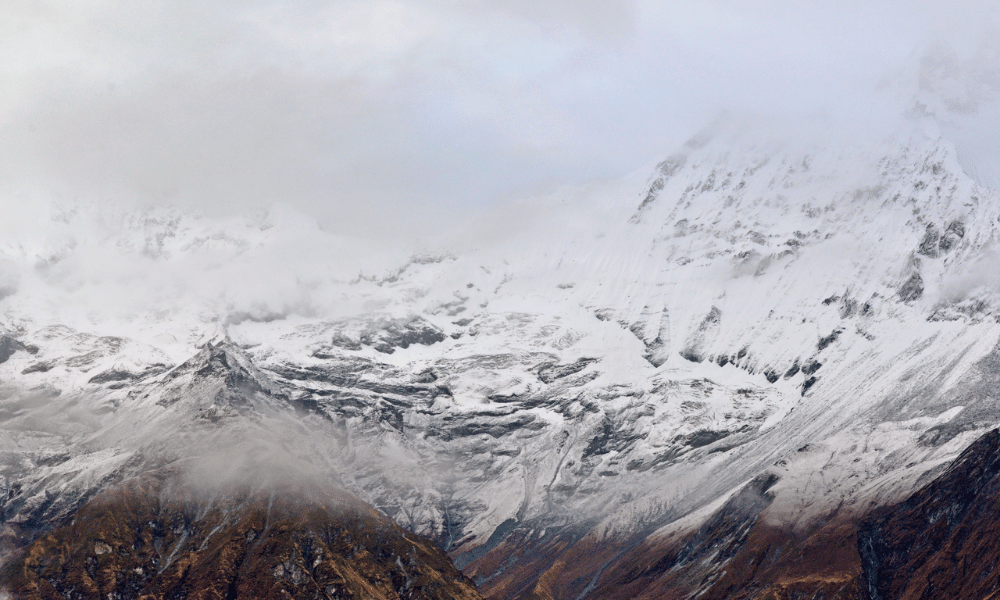
The Annapurna Circuit Trek is a classic and popular trek that takes you through diverse landscapes, ancient villages, and beautiful valleys in the Annapurna region of Nepal. The trek encircles the Annapurna massif, passing through various terrains, including subtropical forests, paddy fields, high alpine meadows, and arid deserts. While certain parts of the trek lie within the rain-shadow, other sections can be affected by the monsoon, so it's essential to plan accordingly.
Thorong La Pass: Cross the challenging Thorong La Pass at 5,416 meters (17,769 feet), the highest point on the trek, which offers panoramic views of the Annapurna massif and surrounding peaks.
Muktinath Temple: Visit the sacred Muktinath Temple, a significant pilgrimage site for both Hindus and Buddhists.
Manang Village: Experience the unique culture and traditions of the Manang people, who live in one of the most remote and picturesque valleys in the region.
Kali Gandaki Gorge: The trek takes you through the world's deepest gorge, the Kali Gandaki Gorge, which separates the Annapurna and Dhaulagiri massifs.
Diverse landscapes: The Annapurna Circuit Trek offers a variety of landscapes, from lush subtropical forests and terraced farmlands to high alpine meadows and arid deserts.
Trekking Duration and Difficulty Level:
The Annapurna Circuit Trek typically takes around 12-21 days to complete, depending on your pace and chosen route. The trek is considered moderate to challenging in difficulty, with daily walking distances of 5-7 hours on average. The highest point of the trek is the Thorong La Pass at an altitude of 5,416 meters (17,769 feet).
Tips for Trekking During the Monsoon Season:
Plan your route carefully: Certain parts of the Annapurna Circuit Trek are more affected by the monsoon than others. Consult with experienced guides or trekking agencies to plan the best route for the season.
Obtain necessary permits: Trekkers need to obtain the Annapurna Conservation Area Permit (ACAP) and the Trekkers' Information Management System (TIMS) card before embarking on the trek.
Hire a guide and porter: A knowledgeable local guide can help ensure a safe and enjoyable trekking experience, while a porter can assist with carrying heavy gear and supplies.
Prepare for variable weather: The weather can be unpredictable during the monsoon season, so pack waterproof clothing and gear to stay dry and comfortable.
Acclimatize properly: The trek involves high-altitude passes and gradual ascents. Take your time to acclimatize properly and be aware of the symptoms of altitude sickness.
Respect local customs and culture: While interacting with the local people and visiting religious sites, it is essential to be respectful of their customs, traditions, and beliefs.
By considering these tips and embracing the diverse landscapes and rich culture of the Annapurna Circuit, trekkers can enjoy a memorable monsoon trekking experience in Nepal.
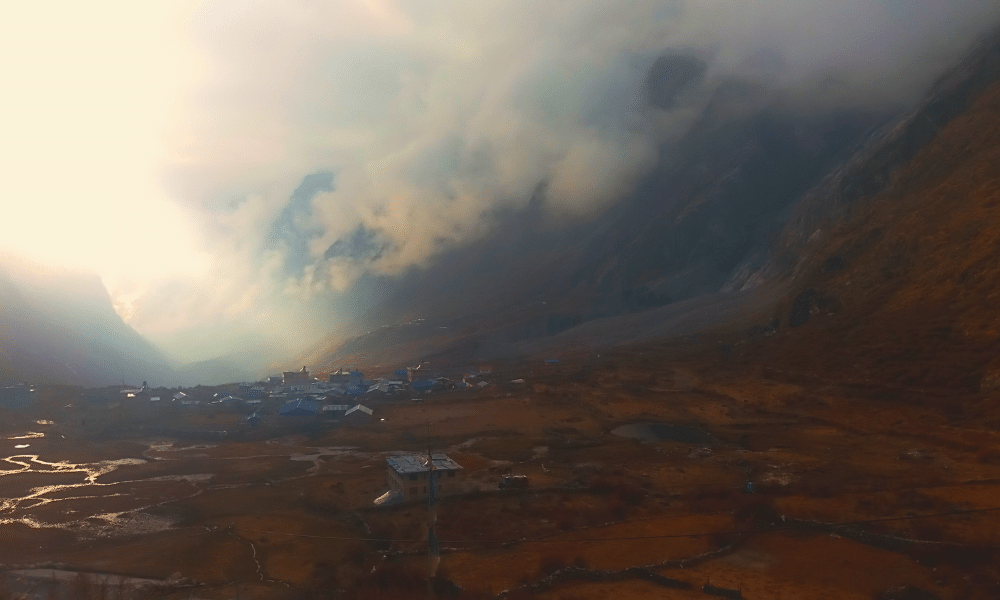
The Langtang Valley Trek takes you through the beautiful and diverse Langtang Valley, situated north of Kathmandu in Nepal. The trek offers a unique opportunity to explore the serene landscapes, lush forests, traditional Tamang villages, and the stunning mountain views of the region. While the Langtang Valley is not in the rain-shadow, it receives comparatively less rainfall than other regions, making it a possible trekking destination during the monsoon season with proper planning and preparation.
Kyanjin Gompa: Visit the ancient Kyanjin Gompa, an important Buddhist monastery in the region, and immerse yourself in the spiritual atmosphere.
Langtang Village: Explore the traditional Tamang village of Langtang, where you can witness the unique culture and traditions of the Tamang people.
Diverse landscapes: The Langtang Valley Trek offers a variety of landscapes, from lush forests and terraced farmlands to high alpine meadows and glaciers.
Wildlife: The region is home to diverse wildlife, including the endangered red panda, Himalayan tahr, and several bird species.
Mountain views: Enjoy the stunning views of the Langtang range, including Langtang Lirung (7,227 meters), Ganesh Himal (7,422 meters), and several other peaks.
Trekking Duration and Difficulty Level:
The Langtang Valley Trek typically takes around 7-10 days to complete, depending on your pace and chosen route. The trek is considered moderate in difficulty, with daily walking distances of 4-6 hours on average. The highest point of the trek is at Kyanjin Ri (4,773 meters) or Tserko Ri (5,000 meters), depending on which viewpoint you choose to climb.
Tips for Trekking During the Monsoon Season:
Plan your route carefully: Consult with experienced guides or trekking agencies to plan the best route and timing for your trek during the monsoon season.
Obtain necessary permits: Trekkers need to obtain the Langtang National Park entry permit and the Trekkers' Information Management System (TIMS) card before embarking on the trek.
Hire a guide and porter: A knowledgeable local guide can help ensure a safe and enjoyable trekking experience, while a porter can assist with carrying heavy gear and supplies.
Prepare for variable weather: The weather can be unpredictable during the monsoon season, so pack waterproof clothing and gear to stay dry and comfortable.
Be cautious of landslides: Monsoon rains can cause landslides in some areas. Stay informed about the trail conditions and follow your guide's advice.
Respect local customs and culture: While interacting with the local people and visiting religious sites, it is essential to be respectful of their customs, traditions, and beliefs.
By considering these tips and embracing the natural beauty and unique culture of the Langtang Valley, trekkers can enjoy a memorable monsoon trekking experience in Nepal.
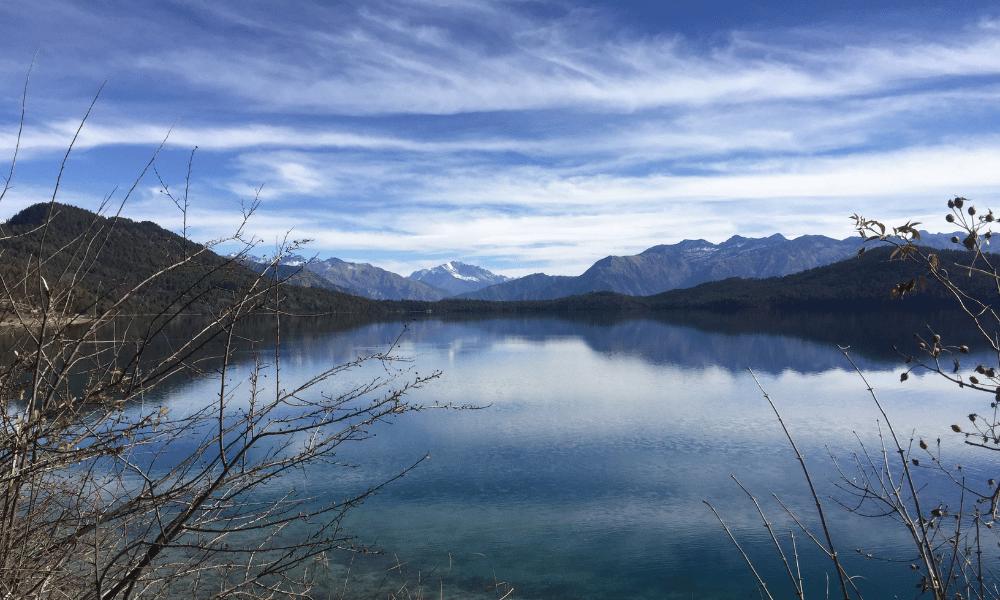
The Rara Lake Trek takes you through the remote and pristine region of western Nepal, culminating at the enchanting Rara Lake, the largest lake in Nepal. The trek offers a unique opportunity to explore the untouched natural beauty, diverse landscapes, and rich cultural heritage of the lesser-known region. The Rara Lake Trek is suitable for trekking during the monsoon season, as it lies in the rain-shadow of the Himalayas.
Rara Lake: The pristine Rara Lake is the centerpiece of the trek, renowned for its clear blue waters and the surrounding lush forests and snow-capped mountains.
Rara National Park: The trek takes you through the beautiful Rara National Park, home to diverse wildlife, including the endangered red panda, musk deer, and several bird species.
Traditional villages: Experience the unique culture and traditions of the local people living in remote villages along the trail.
Diverse landscapes: The Rara Lake Trek offers a range of landscapes, from lush forests and alpine meadows to arid cliffs and high mountain passes.
Off-the-beaten-path experience: Enjoy the tranquility and solitude of this less-traveled region, away from the crowds of more popular trekking routes.
Trekking Duration and Difficulty Level:
The Rara Lake Trek typically takes around 10-14 days to complete, depending on your pace and chosen route. The trek is considered moderate in difficulty, with daily walking distances of 5-7 hours on average. The highest point of the trek is at an altitude of approximately 3,710 meters (12,172 feet) at Rara Lake.
Tips for Trekking During the Monsoon Season:
Obtain necessary permits: Trekkers need to obtain a restricted area permit for the Rara Lake Trek, along with the Rara National Park entry permit.
Hire a guide and porter: A knowledgeable local guide can help ensure a safe and enjoyable trekking experience, while a porter can assist with carrying heavy gear and supplies.
Prepare for variable weather: Despite being in the rain-shadow, the Rara Lake region can still experience occasional rain during the monsoon. Pack waterproof clothing and gear to stay dry and comfortable.
Be cautious of landslides: Monsoon rains can cause landslides in some areas. Stay informed about the trail conditions and follow your guide's advice.
Respect local customs and culture: While interacting with the local people and visiting religious sites, it is essential to be respectful of their customs, traditions, and beliefs.
By considering these tips and embracing the natural beauty and unique culture of the Rara Lake region, trekkers can enjoy an unforgettable monsoon trekking experience in Nepal.
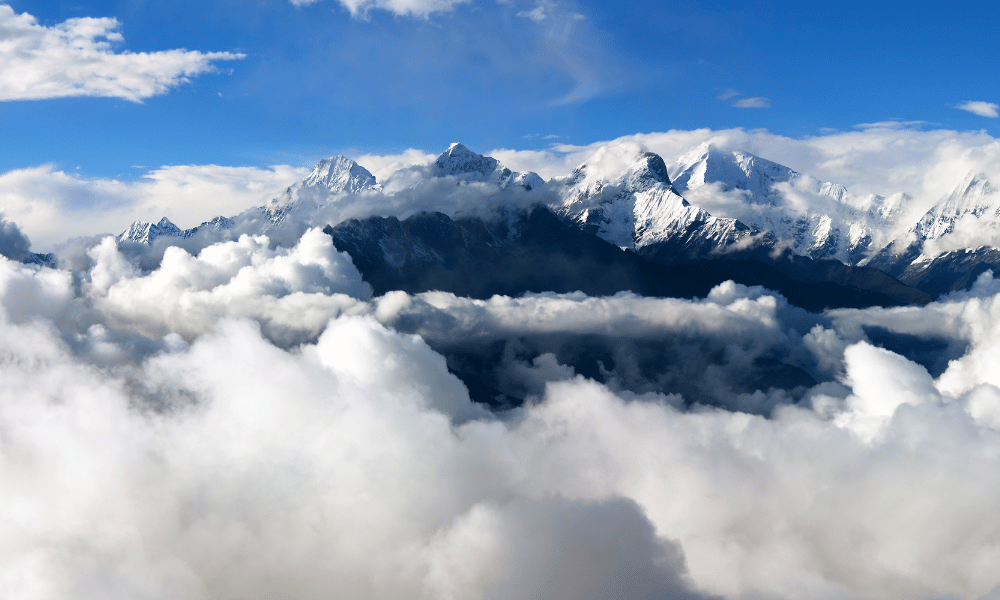
The Ruby Valley Trek is an off-the-beaten-path trekking experience that takes you through the picturesque Ganesh Himal and Ruby Valley regions of central Nepal. This lesser-known trek offers a unique opportunity to explore the untouched natural beauty, diverse landscapes, and rich cultural heritage of the Tamang and Gurung communities. Although not in the rain shadow, Ruby Valley Trek receives comparatively less rainfall than other regions during the monsoon season, making it possible to trek with proper planning and preparation.
Traditional villages: Visit traditional Tamang and Gurung villages along the trail, where you can witness their unique culture, traditions, and lifestyle.
Ganesh Himal: Enjoy the stunning views of the Ganesh Himal range, including Ganesh I (7,429 meters), Ganesh II (7,118 meters), and several other peaks.
Pangsang Pass: Cross the Pangsang Pass (3,842 meters), which offers panoramic views of the surrounding mountains and valleys.
Diverse landscapes: The Ruby Valley Trek offers a variety of landscapes, from terraced farmlands and lush forests to high alpine meadows and stunning valleys.
Local homestays: Experience the warm hospitality of the local people by staying in their homes and learning about their day-to-day life.
Trekking Duration and Difficulty Level:
The Ruby Valley Trek typically takes around 10-14 days to complete, depending on your pace and chosen route. The trek is considered moderate in difficulty, with daily walking distances of 5-7 hours on average. The highest point of the trek is the Pangsang Pass at an altitude of 3,842 meters (12,605 feet).
Tips for Trekking During the Monsoon Season:
Plan your route carefully: Consult with experienced guides or trekking agencies to plan the best route and timing for your trek during the monsoon season.
Obtain necessary permits: Trekkers need to obtain the Trekkers' Information Management System (TIMS) card before embarking on the trek. Additional permits might be required depending on your chosen route.
Hire a guide and porter: A knowledgeable local guide can help ensure a safe and enjoyable trekking experience, while a porter can assist with carrying heavy gear and supplies.
Prepare for variable weather: The weather can be unpredictable during the monsoon season, so pack waterproof clothing and gear to stay dry and comfortable.
Be cautious of landslides: Monsoon rains can cause landslides in some areas. Stay informed about the trail conditions and follow your guide's advice.
Respect local customs and culture: While interacting with the local people and visiting religious sites, it is essential to be respectful of their customs, traditions, and beliefs.
By considering these tips and embracing the natural beauty and unique culture of the Ruby Valley, trekkers can enjoy a memorable monsoon trekking experience in Nepal.
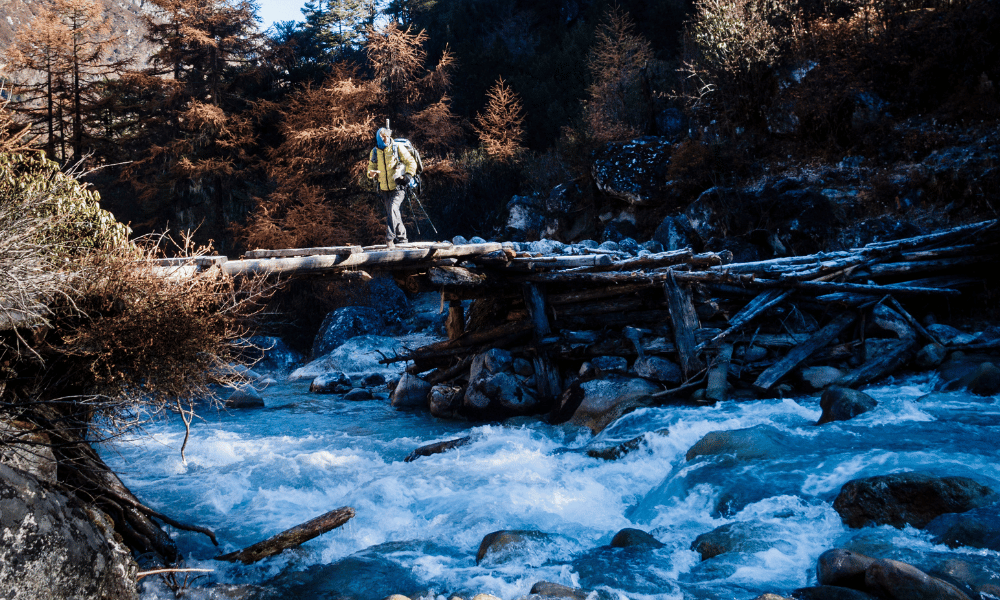
The Kanchenjunga Base Camp Trek is a remote and adventurous trekking experience that takes you to the base camps of the world's third-highest peak, Mount Kanchenjunga (8,586 meters). Situated in eastern Nepal, the trek offers a unique opportunity to explore the untouched natural beauty, diverse landscapes, and the rich cultural heritage of the local communities. The trek is challenging and less frequented by trekkers, providing a more authentic and off-the-beaten-path experience. During the monsoon season, the Kanchenjunga region receives significant rainfall, so proper planning and preparation are crucial.
Kanchenjunga Base Camps: Visit both the North and South Base Camps of Mount Kanchenjunga, offering close-up views of the impressive peak.
Diverse landscapes: The Kanchenjunga Base Camp Trek offers a variety of landscapes, from lush forests and terraced farmlands to high alpine meadows, glaciers, and stunning valleys.
Traditional villages: Experience the unique culture and traditions of the local Limbu, Rai, and Sherpa communities living in remote villages along the trail.
Kanchenjunga Conservation Area: Trek through the Kanchenjunga Conservation Area, home to diverse wildlife, including the snow leopard, red panda, and various bird species.
Panoramic mountain views: Enjoy breathtaking views of the Kanchenjunga massif and other Himalayan peaks, such as Makalu, Lhotse, and Everest.
Trekking Duration and Difficulty Level:
The Kanchenjunga Base Camp Trek typically takes around 20-25 days to complete, depending on your pace and chosen route. The trek is considered challenging in difficulty due to its remoteness, high altitude, and long duration. Daily walking distances are about 6-8 hours on average. The highest point of the trek is at an altitude of 5,160 meters (16,929 feet) at Lapsang La Pass or 5,143 meters (16,873 feet) at Sele La Pass, depending on the chosen route.
Tips for Trekking During the Monsoon Season:
Plan your route carefully: Consult with experienced guides or trekking agencies to plan the best route and timing for your trek during the monsoon season.
Obtain necessary permits: Trekkers need to obtain the Kanchenjunga Conservation Area Permit (KCAP) and the Trekkers' Information Management System (TIMS) card before embarking on the trek.
Hire a guide and porter: A knowledgeable local guide can help ensure a safe and enjoyable trekking experience, while a porter can assist with carrying heavy gear and supplies.
Prepare for variable weather: The weather can be unpredictable during the monsoon season, so pack waterproof clothing and gear to stay dry and comfortable.
Be cautious of landslides and flooding: Monsoon rains can cause landslides and flooding in some areas. Stay informed about the trail conditions and follow your guide's advice.
Acclimatize properly: The trek involves high-altitude passes and gradual ascents. Take your time to acclimatize properly and be aware of the symptoms of altitude sickness.
Respect local customs and culture: While interacting with the local people and visiting religious sites, it is essential to be respectful of their customs, traditions, and beliefs.
By considering these tips and embracing the natural beauty and unique culture of the Kanchenjunga region, trekkers can enjoy a memorable monsoon trekking experience in Nepal.
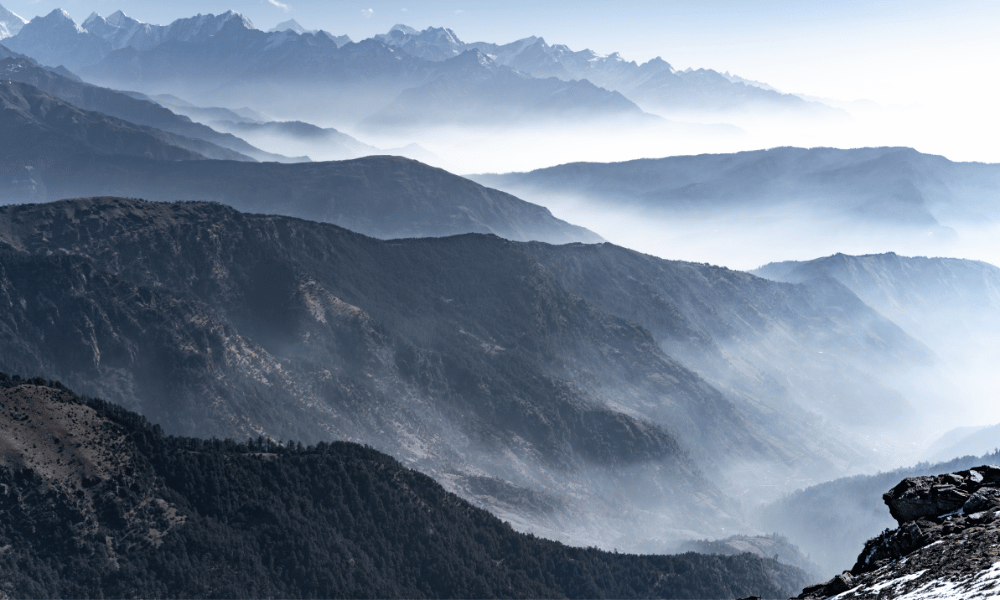
The Pikey Peak Trek is a short and relatively easy trek located in the lower Solu Khumbu region of eastern Nepal. It offers a unique opportunity to explore the cultural richness of the area, including monasteries and traditional Sherpa villages, while enjoying the stunning views of the Everest range and other surrounding peaks. Although not in the rain shadow, the Pikey Peak Trek receives comparatively less rainfall during the monsoon season, making it a possible trekking destination with proper planning and preparation.
Pikey Peak summit: Reach the summit of Pikey Peak (4,065 meters) and enjoy panoramic views of the Everest range, Makalu, Annapurna, and Kanchenjunga, among others.
Traditional Sherpa villages: Visit charming Sherpa villages, such as Junbesi and Taklung, and witness their unique culture, traditions, and lifestyle.
Thupten Chholing Monastery: Explore the Thupten Chholing Monastery, an important Buddhist pilgrimage site in the region, and immerse yourself in the spiritual atmosphere.
Rhododendron forests: During spring, the trek offers beautiful rhododendron forests, which bloom with vibrant colors.
Cultural experience: The Pikey Peak Trek offers a rich cultural experience, as it passes through various ethnic communities, including Sherpa, Magar, and Tamang people.
Trekking Duration and Difficulty Level:
The Pikey Peak Trek typically takes around 6-8 days to complete, depending on your pace and chosen route. The trek is considered easy to moderate in difficulty, with daily walking distances of 4-6 hours on average. The highest point of the trek is the Pikey Peak summit at an altitude of 4,065 meters (13,337 feet).
Tips for Trekking During the Monsoon Season:
Plan your route carefully: Consult with experienced guides or trekking agencies to plan the best route and timing for your trek during the monsoon season.
Obtain necessary permits: Trekkers need to obtain the Trekkers' Information Management System (TIMS) card before embarking on the trek. Additional permits might be required depending on your chosen route.
Hire a guide and porter: A knowledgeable local guide can help ensure a safe and enjoyable trekking experience, while a porter can assist with carrying heavy gear and supplies.
Prepare for variable weather: The weather can be unpredictable during the monsoon season, so pack waterproof clothing and gear to stay dry and comfortable.
Be cautious of landslides: Monsoon rains can cause landslides in some areas. Stay informed about the trail conditions and follow your guide's advice.
Respect local customs and culture: While interacting with the local people and visiting religious sites, it is essential to be respectful of their customs, traditions, and beliefs.
By considering these tips and embracing the natural beauty and unique culture of the Pikey Peak region, trekkers can enjoy a memorable monsoon trekking experience in Nepal.
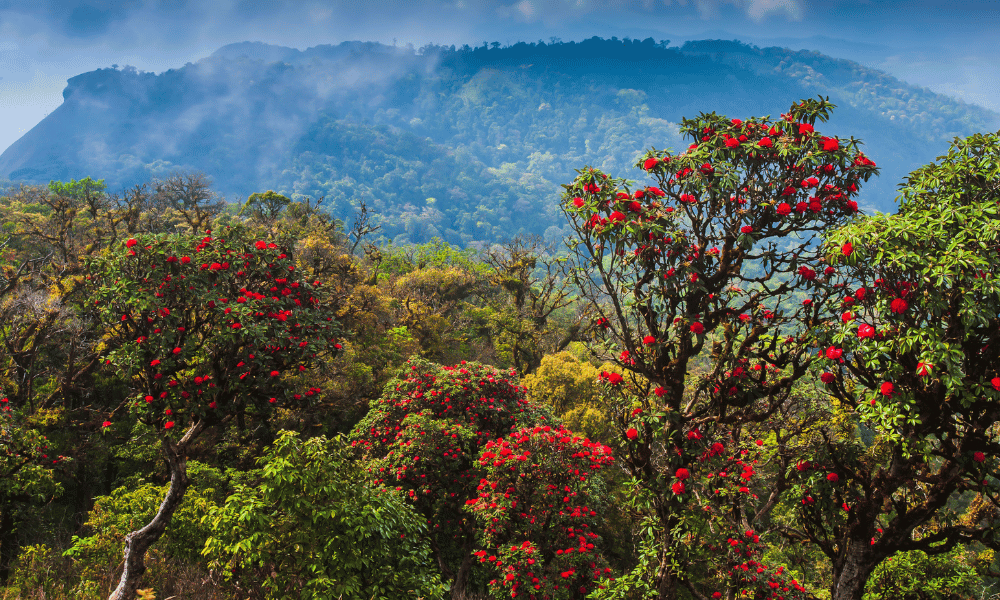
The Helambu Trek is a short and relatively easy trek located in the Langtang region of central Nepal, just north of Kathmandu Valley. The trek offers an opportunity to explore the cultural richness of the area, including traditional Tamang and Sherpa villages, and enjoy the beautiful landscapes of terraced fields, lush forests, and snow-capped mountains. The Helambu region receives significant rainfall during the monsoon season, so proper planning and preparation are crucial for trekking during this time.
Traditional villages: Visit traditional Tamang and Sherpa villages, such as Tarkeghyang and Sermathang, and witness their unique culture, traditions, and lifestyle.
Scenic landscapes: The Helambu Trek offers diverse landscapes, from terraced fields and lush forests to high alpine meadows and snow-capped peaks.
Ancient monasteries: Explore ancient monasteries, such as Tarkeghyang Monastery and Melamchi Ghyang Monastery, and immerse yourself in the spiritual atmosphere.
Rhododendron forests: During spring, the trek offers beautiful rhododendron forests, which bloom with vibrant colors.
Accessibility: The trek's proximity to Kathmandu makes it easily accessible and an excellent choice for those with limited time.
Trekking Duration and Difficulty Level:
The Helambu Trek typically takes around 7-10 days to complete, depending on your pace and chosen route. The trek is considered easy to moderate in difficulty, with daily walking distances of 4-6 hours on average. The highest point of the trek is Tharepati at an altitude of 3,650 meters (11,975 feet).
Tips for Trekking During the Monsoon Season:
Plan your route carefully: Consult with experienced guides or trekking agencies to plan the best route and timing for your trek during the monsoon season.
Obtain necessary permits: Trekkers need to obtain the Langtang National Park entry permit and the Trekkers' Information Management System (TIMS) card before embarking on the trek.
Hire a guide and porter: A knowledgeable local guide can help ensure a safe and enjoyable trekking experience, while a porter can assist with carrying heavy gear and supplies.
Prepare for variable weather: The weather can be unpredictable during the monsoon season, so pack waterproof clothing and gear to stay dry and comfortable.
Be cautious of landslides: Monsoon rains can cause landslides in some areas. Stay informed about the trail conditions and follow your guide's advice.
Respect local customs and culture: While interacting with the local people and visiting religious sites, it is essential to be respectful of their customs, traditions, and beliefs.
By considering these tips and embracing the natural beauty and unique culture of the Helambu region, trekkers can enjoy a memorable monsoon trekking experience in Nepal.
Trekking during the monsoon season in Nepal offers a unique opportunity to experience the beauty and challenges of the Himalayas in a different light. Lush landscapes, fewer crowds, and the chance to witness local cultural celebrations make monsoon treks an unforgettable adventure.
To ensure a successful monsoon trek, it is crucial to prepare adequately and follow safety guidelines. Some key considerations include:
Planning your route carefully and consulting with experienced guides or trekking agencies
Obtaining necessary permits and hiring a knowledgeable local guide and porter
Packing waterproof clothing and gear, as well as preparing for variable weather conditions
Being cautious of landslides and staying informed about trail conditions
Respecting local customs, traditions, and beliefs while interacting with local people and visiting religious sites
Acclimatizing properly and being aware of altitude sickness symptoms
By embracing the unique beauty and challenges of trekking in Nepal during the monsoon season and following the essential safety guidelines, you can enjoy a memorable and life-changing experience in the majestic Himalayas.
The monsoon season in Nepal typically begins in June and lasts until August, with the peak rainfall usually occurring in July.
Yes, it is possible to trek safely in Nepal during the monsoon season with proper planning, preparation, and adherence to safety guidelines. Some treks are more suitable for the monsoon season than others, especially those in rain-shadow areas.
The main challenges of trekking during the monsoon season include heavy rainfall, slippery trails, increased risk of landslides, occasional flooding, and limited visibility.
Some advantages of trekking during the monsoon season include lush landscapes, fewer crowds, lower trekking costs, and the opportunity to witness unique cultural celebrations and local flora.
For a monsoon trek in Nepal, pack waterproof clothing (such as a rain jacket and pants), sturdy trekking boots with good grip, quick-drying clothes, warm layers, waterproof backpack cover, and trekking poles for added stability.
While not mandatory for all treks, hiring a knowledgeable local guide is highly recommended for a monsoon trek in Nepal. A guide can help ensure a safe and enjoyable trekking experience, navigate challenging trails, and provide valuable insights into local culture and traditions.
Yes, most tea houses remain open during the monsoon season. However, some remote trekking routes may have fewer open teahouses, so it's essential to plan and consult with a guide or trekking agency about accommodation options.
To minimize the risk of landslides, choose a trek that is less prone to landslides during the monsoon season, stay informed about trail conditions, and follow your guide's advice. Avoid walking during or immediately after heavy rainfall, and stay on established trails.
To prevent leeches, wear long pants tucked into your socks, use insect repellent, and consider wearing leech socks. Regularly check for leeches and remove them safely if found.
To stay healthy during a monsoon trek in Nepal, drink only purified or boiled water, eat freshly cooked food, wash your hands frequently, and carry a first-aid kit with essential medicines. Be aware of the symptoms of altitude sickness and acclimatize properly during high-altitude treks.